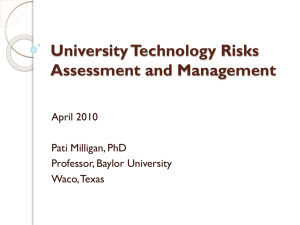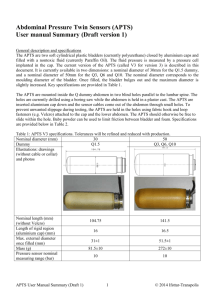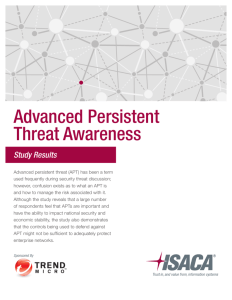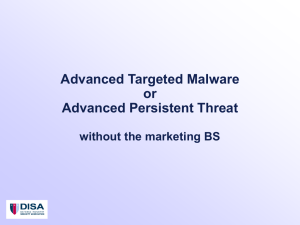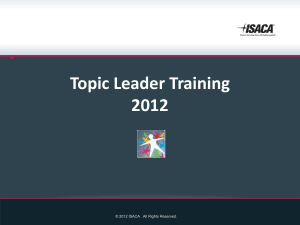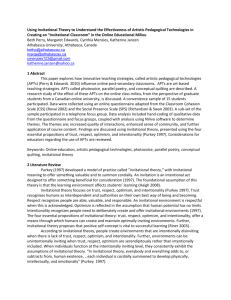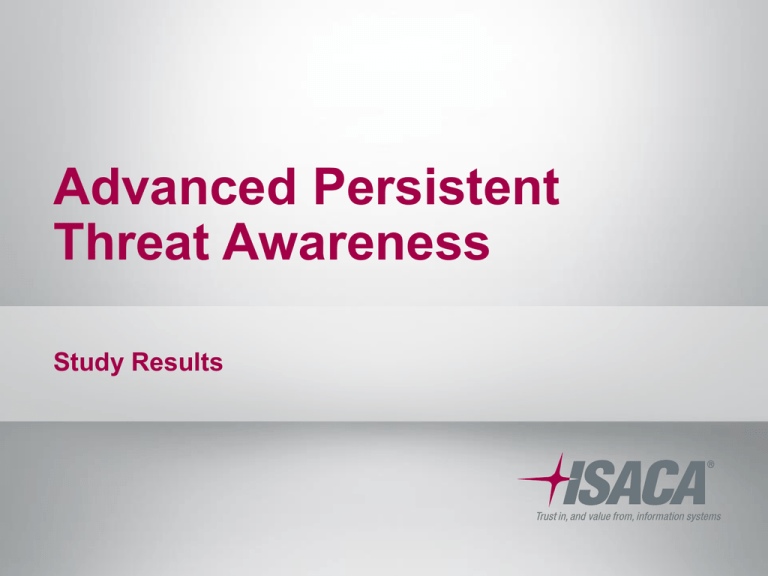
Advanced Persistent
Threat Awareness
Study Results
The 2010 Google Aurora attack
forever changed the way we
look at Internet security.
This large-scale, sophisticated
attack showed us that all
sectors, from private to public,
are vulnerable to a new class
of security breach:
© 2013 ISACA. All rights reserved
The
Advanced
Persistent
Threat
ADVANCED,
STEALTHY AND
CHAMELEON-LIKE
in its adaptability, APTs were
once thought to be limited to
attacks on government
networks.
APTs exploit
zero-day
threats –
unknown
weakness.
© 2013 ISACA. All rights reserved
APTs also
often take
the form of
well-designed
spear fishing
attacks.
3
Following the Google attacks*
similar targeted intrusions quickly
followed, garnering media
scrutiny – and growing concern
that the APT was more damaging
than it seemed.
The 2011 RSA
SecurID attack
was attributed
to an APT.
So was the
Internet worm
“Flame.”
*Google attacks affected nearly three
dozen well-known tech, finance and
defense enterprises
© 2013 ISACA. All rights reserved
4
How well do security
professionals understand APTs?
How are they affecting different
industries and organizations
throughout the world?
What is being done
to prevent them?
© 2013 ISACA. All rights reserved
In Q4 of 2012, ISACA
launched the APT
Awareness Survey
to find out.
5
So ISACA asked 1,500 people
worldwide – from tech service
consultants, to people in the
banking industry – about APTs.
19%
%
32
North America
Asia
8%
38%
3%
Latin America
Oceania
Europe / Africa
© 2013 ISACA. All rights reserved
6
AWARENESS
42.5% of respondents
were familiar…
25%
Very
Familiar
28.6%, somewhat familiar…
And only 25.1% very familiar
about APTs.
42%
Familiar
Overall, 96.2% were somewhat
familiar with APTs…
But most importantly:
93.6%
of respondents understood
APTs as a very credible,
serious threat to national
security and economic stability.
29%
Somewhat
Familiar
4%
Not at All
Familiar
© 2013 ISACA. All rights reserved
7
Just 46.6% of respondents
believed that APTs were a
unique threat.
And more than half (53.4%)
believe this advanced set of
threats is no different to what
they’ve been dealing
with in the past.
53%
Similar
47%
Unique
WHAT DOES
THIS MEAN?
© 2013 ISACA. All rights reserved
8
There’s a huge
disconnect in the IT
industry about APTs …
A lack of understanding and education.
© 2013 ISACA. All rights reserved
Highest Risks on
Enterprises from APTs
87.3%
BELIEVE
THAT
JAILBREAKS, ROOTING &
BYOD GREATLY INCREASE
THE CHANCES OF AN APT
OCCURRING.
Other key highlights
89.7% of respondents believe the use
of social networking sites like Facebook
or Twitter increases the likelihood of a
successful APT attack.
© 2013 ISACA. All rights reserved
10
Suffering with an APT
Although just 21.6% of
respondents reported having
been victims of an APT attack
63% – three times that amount –
believe it’s only a matter of time
before their business is targeted.
© 2013 ISACA. All rights reserved
63%
BELIEVE IT’S
ONLY A MATTER
OF TIME BEFORE
THEIR BUSINESS
IS TARGETED.
11
The majority of survey takers –
up to 60% – believed that they
have the ability to ID, respond to
and stop a successful APT attack.
31.1% said they have incident
management plans in place to
fight an APT.
49.5% are prepared, but without
a concrete solution.
How able is your enterprise to deal with
an APT attack?
Detect APT
Attacks
Respond
to APT
Attacks
Stop a
Successful
Attack
0%
© 2013 ISACA. All rights reserved
20%
Very Able
Not Able
Able
Not at All Able
40%
60%
12
How are
people handling
the threats?
Most respondents are
using technology in a
risk based layered
approach to prevent
and combat APTs.
© 2013 ISACA. All rights reserved
94.9%
Anti-Virus / Anti-Malware
92.8%
Network Tech (Firewalls, etc.)
71.2%
IPS
A Troubling
Lack of Initiative
Has your enterprise increased security
training as a result of APTs?
There aren’t enough precautions
being taken against the threat of
an APT.
Yes
Up to 81.8% of survey takers
have not updated their
agreements with vendors who
provide protection against APT.
And 67.3% reported that they
haven’t held any APT
awareness training programs for
their employees.
© 2013 ISACA. All rights reserved
No
0%
20%
40%
Very Likely
Not Very likely
Likely
Not at All Likely
60%
80%
14
APTs are serious threats.
We need more consideration
to their consequences.
Enterprises must adopt more technology awareness
training, vendor management, incident management
and increased attention from executives.
© 2013 ISACA. All rights reserved
Conclusion
Advanced Persistent Threats
differ from the traditional,
average virus, and need to be
classified as such. Many
enterprises and companies
have made some positive
inroads into fighting APTs, like
better security management.
But there’s still a lack
of cohesion and
understanding to
what APTs are and how
to defend against them.
But there’s still a lack of
cohesion and understanding to
what APTs are and how to
defend against them. Market
conditions have not sufficiently
changed, and the technology to
fight APTs isn’t fully evolved yet.
© 2013 ISACA. All rights reserved
16
Take
Action
Against
APTs
ISACA is here to serve its members
against any security breach – especially
the Advanced Persistent Threat.
A series of educational products to
address challenges in cyber security,
and guard against APTs, is currently
in development.
To learn more visit us at
WWW.ISACA.ORG/CYBERSECURITY
© 2013 ISACA. All rights reserved
QUESTIONS &
COMMENTS
© 2013 ISACA. All rights reserved


